Who’s Using AI Virtual Try-On Photos to Build Brands—and Why It’s Working
 Pic Copilot Team
Pic Copilot TeamHow are AI virtual try-on images becoming a key engine behind viral fashion content? This blog dives into five types of high-traffic content creators—from drama-style influencers and aesthetic vloggers to fan-based sellers and fashion-focused student creators—and how they use Pic Copilot’s AI Try-On Tool to rapidly generate high-impact outfit visuals and elevate brand visibility.
We’ll break down real-world scenarios, highlight standout features, and explore how the “upload-to-output” workflow transforms content production speed, enables fast style-to-scene matching, and helps creators go viral across platforms.
Chapter 1: What Is AI Virtual Try-On? A New Way to Create Outfit Visuals
AI virtual try-on images combine AI-generated models with auto-matched backgrounds. With no need for real models or physical shoots, users simply upload product images and instantly get styled visuals aligned with their brand tone.
It’s especially useful for content-heavy creators like fashion influencers, cross-border eCommerce sellers, and visual bloggers—cutting costs and speeding up creation.
Three core advantages of Pic Copilot Try-On: - Light-touch workflow: Upload clothing image, get instant try-on result - High flexibility: Supports different models, postures, and backgrounds - Fast output: Bulk generation possible—about 2 minutes per image
Ideal for: Xiaohongshu outfit posts, TikTok challenge covers, Shopify product pages, Pinterest lookbooks, blog banners, etc.
Chapter 2: Drama-Inspired Looks—How Series Fans Create “TV Style” Content
Outfit recreations inspired by hit dramas and reality shows are fan-favorite formats. Traditionally, creators would mimic outfits with real models and scout locations for shoots—a slow and costly process.
With Pic Copilot, creators can now upload a single garment image and generate AI model visuals that match drama character aesthetics, with no human modeling or set building needed.
Real Examples: - Preview posts before the show airs:
e.g., “Replica of Fan Xian’s cape from Joy of Life 2” garners pre-release buzz - Mid-season outfit grids:
e.g., “Emily in Paris—5 Look Collage” - Post-season collections: evergreen traffic through “Drama Look Recap” posts
Pic Copilot’s smart match system:
- Suggests fitting backgrounds (e.g., “Paris streets,” “European balcony,” “vintage hotel”)
- Allows multi-pose generation: standing, walking, turning—offering style variety with a single outfit
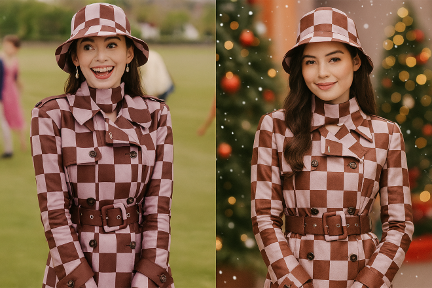
Chapter 3: Aesthetic Vloggers—Creating “Mood-Based Looks” Without Appearing On Camera
Visual vloggers favor emotional storytelling and atmospheric detail. With Pic Copilot, they can generate outfit visuals without being in front of the camera, maintaining their brand’s visual rhythm without the time cost of shooting.
Common scene pairings:
- “Rainy solo mood” → long coat + alley shot, walking away
- “Morning café light” → knit top + seated figure outside coffee shop
- “Afternoon outing” → oversized tee + sunlit urban corner
Features vloggers use most:
- 7-day mood pack: upload 7 outfits, get 7 emotional backdrops
- Seasonal drops: from spring to rainy season to fall
- Vlog-style grids: automatically compiled from outfit sets
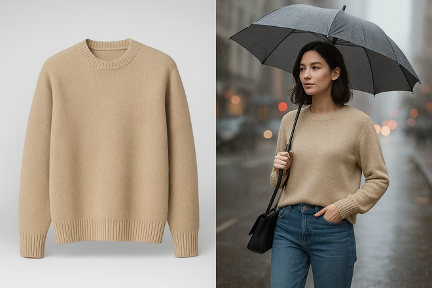
Chapter 4: Fan Merch Sellers—Recreating Celebrity Looks Without Real Stars
Fan-based fashion sellers often rely on celebrity influence—but using real star photos brings copyright risks and visual inconsistency.
Pic Copilot lets them upload star-inspired garments and generate AI models styled with similar vibes and signature backgrounds (e.g., airport photos, stage lights, MV backdrops).
Popular fan aesthetics:
- “Jennie airport look” → knit top + twin braid hairstyle
- “Lisa dance vibe” → 5-look collage with stage lighting backgrounds
Customization capabilities:
- Create “celebrity-style model templates”: cold chic, sweet sporty, playful - Adjust poses like walking away, sunglasses, tilted head for airport mood
- Combine in collages: one outfit, different poses, creating rich visual sets
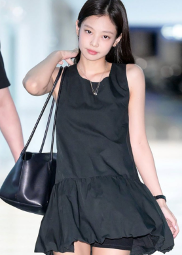
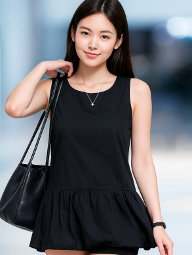
Chapter 5: Student Lifestyle Creators—Showing Campus Fashion Without Real Shoots
Student influencers—especially international or bilingual ones—often create content comparing US/UK campus styles, class-ready outfits, and subway commutes. AI try-on tools allow them to create high-volume, consistent campus visuals.
Scenarios include:
- US vs. UK school looks: hoodies + jeans vs. trench + boots
- Library, lecture hall, subway, or cafeteria backdrops to simulate real school life
- Seasonal outfit guides: London rainwear vs. LA summer layers
Useful Pic Copilot features:
- Scene sets like: subway, dorms, lecture halls, after-school courts
- Style comparisons with different models in the same outfit
- Grid or card layouts for Notion, Xiaohongshu publishing
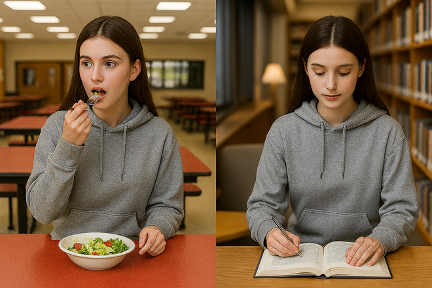
Chapter 6: TikTok Outfit Challenges—Creating 5 Looks from One Item
TikTok creators thrive on quick visual challenges like “1 skirt, 5 ways to wear it.” With AI try-on, they can instantly generate multiple styled images from a single item, saving time and boosting consistency.
Popular challenge content:
- 5 looks in one post: same model, different poses and backdrops
- Simulated scenes like street, gym, travel, office, date night
- “Vote your favorite look” interactions with numbered images
Pic Copilot challenge features:
- One-click multi-look generation in 1:1 or 16:9 layout
- Choose model variations: hairstyle, skin tone, body type
- Auto background match based on selected theme (e.g., bookstore, gym)
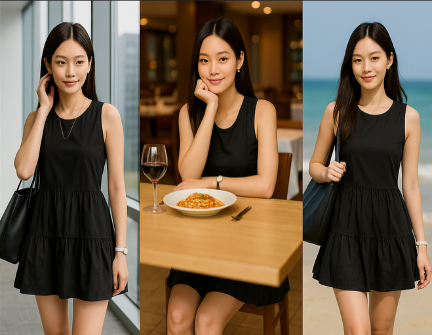
Chapter 7: Why AI Try-On Works Across Styles and Audiences
AI try-on’s strength lies in its adaptability—visually and technically:
1. Broad Model Options
· Pick from Asian, Western, Black, Latinx appearances
· Use emotion models: sweet, aloof, athletic, sophisticated
· Fit any gender or fashion identity
2. Style Diversity
· Match Korean, French vintage, academic, minimal, streetwear tones
· Customize backgrounds: palace streets, rainy parks, Japanese bedrooms
· Output for TikTok, Pinterest, Instagram, Weibo, Xiaohongshu, Shopify, etc.
3. Visual Consistency
· Same item + different scenes = uniform lighting and clarity
· Ideal for set collections, grids, and lookbooks with visual harmony
Chapter 8: The Smart Technology Behind Pic Copilot
Module 1: Model + Outfit Matcher
· Detects item type (jacket, dress, shirt, pants)
· Suggests best-fit models based on cut, style, and vibe
· Keeps texture and garment behavior (draping, folds) natural
Module 2: Smart Background Selector
· Matches clothing style to scenes (e.g., floral = garden, blazer = office)
· Auto-adjusts light/shadow to blend model and setting
· Allows custom uploads for branded visuals
Module 3: Bulk Generator
· Make 3–9 look collages in under 10 minutes
· Choose export formats: 1:1 grid, landscape header, vertical scroll
· Perfect for challenges, seasonal posts, and batch publishing
Chapter 9: Upload and Output Best Practices
Upload Tips
· Ideal size: 800px wide × 600–800px tall
· Clean images with no background or white backdrop preferred
· Avoid shadows, clips, or overly folded garments
Background Tips
· Use built-in scenes or upload brand-specific ones
· Apply keyword-based matching: “Paris café,” “rainy corridor,” “school hall”
· Plan visuals in themed batches (e.g., seasonal, aesthetic, by model type)
Output Format Tips
· 16:9 for cover use (Xiaohongshu, TikTok)
· 1:1 grids for Pinterest or blog visuals
· Vertical images for eCommerce listings
· Tip: High-volume accounts can treat Pic Copilot as their image hub for weekly upload and batch publishing
Chapter 10: Final Thoughts—AI Try-On Is Now a Brand Foundation Tool
Across five creator types, we’ve seen how AI try-on images aren’t just a shortcut to replace model shoots—they’re a foundational asset for building scalable, cohesive, and engaging brand visuals.
Key takeaways:
- Solve the pain of slow, high-cost fashion photo production
- Help creators establish content identity and viral potential
- Deliver scalable, style-consistent outputs across platforms
- Position your visual system for future expansion into video try-ons, landing pages, and visual CMS tools
In short: the earlier you adopt AI try-on visuals, the faster you can claim visual space in the fashion content race.
 Virtual Try On
Virtual Try On AI Model Swap
AI Model Swap Fashion Reels
Fashion Reels Product Avatars
Product Avatars Product AnyShoot
Product AnyShoot Virtual Try On Accessories
Virtual Try On Accessories AI Backgrounds
AI Backgrounds Style Clone
Style Clone Remove Watermark
Remove Watermark AI Templates
AI Templates Image Translator
Image Translator AI Dubbing
AI Dubbing Virtual Try On Shoes
Virtual Try On Shoes AI Avatars
AI Avatars Background Remover
Background Remover AI Shadows
AI Shadows Image Upscaler
Image Upscaler Image Enhancer
Image Enhancer